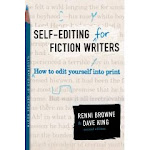A weak POV pulls us out of the story and can confuse our readers, especially if we’re head hopping throughout the story—keeping track of the thoughts of all the characters.
What is POV? It's everything one character sees, feels, hears, tastes and smells. Everything we readers see, should be what that one character sees. Pretend we are a camera placed in a character’s eyes and we’ve set up wire connections to each and every nerve—we are that character. Let's say we’re driving in a car. We shouldn't be able to see what’s going on in someone’s home miles away. Or while we’re driving the car, we shouldn't be able to hear the thoughts of the person in the passenger seat. Your readers will become confused about setting (if we jump from the car to a home miles away), and if we jump into another character’s thoughts. If readers are confused, they have to reread to find out where they are. The last thing a writer wants is to make his readers have to back up and reread everything, and if they get confused, that's what will happen.
A good POV tightens our connection to the main character. We feel his excitement, his fear. We see what he sees. His experiences become ours. When something surprises him, we’re surprised with him because we didn’t see it coming.
So, what if you want to show the thoughts of more than one character? Most editors suggest at every change of time, setting and point of view there should be a double-space between paragraphs. This will keep readers from becoming confused.
Here's a note about POV from Self-Editing for Fiction Writers by Dave King and Rennie Browne:
Some authors get into trouble with their point of view because they are trying to track the emotions of everyone involved in the scene. After all, the easiest way to show how someone feels is through interior monologue—get into his or her head and tell your readers what’s there. So when you have several characters in a scene, there’s an understandable temptation to simply write interior monologues for all of them.
And it’s a temptation we hope you’ll resist. For one thing, shifting the point of view back and forth is likely to do more damage to the flow of the scene than the various viewpoints are worth. (Your readers adjust to being in someone’s head—they assume that they are seeing the scene through that character’s eyes. So when you shift to another character, you throw them off their stride, even if just for a moment.) For another, using interior monologue to show your character’s reactions is just one step away from telling. It is far more effective to stick with a single point of view and show us how your other characters feel through their dialogue and actions.
I recommend you get Self-Editing for Fiction Writers. King and Browne talk about all the necessary tools for writing great fiction, and they devote an entire chapter to Point of View.
When he's available, Dave will join us on this topic by answering some of our questions. If you have any questions for him, please leave them below. I can't guarantee he'll have time to answer everything, but if we compile a list, he'll do what he can. Please keep the questions POV related.
Monday, October 5, 2009
Subscribe to:
Post Comments (Atom)












Thanks Sandi and Dave! Wow, this is a great opportunity. My first question is: I am writing in my hero's POV. He is watching and interacting with a secondary character that he knows pretty well. I write "The woman bristled with unspoken opinion." To me, I believe a POV character can tell when someone is itching to speak. But I've been told this is a POV hop.
ReplyDeleteSecond question: I was told once that when you are in 'deep POV' and you use the POV character's name, you pull the reader out of deep POV because they are reminded that they are not really in that character's head. This is pretty near impossible to avoid completely anyway, but what is your opinion on that? Thanks, Debra
thanks for this post! very informative.
ReplyDeletewhen in deep POV, is there a rule for addressing relatives of the main character? it seems funny to always say "mom" or "dad" or something...but if i were writing in 1st person, that's what i'd do. any thoughts?
I also wanted to let you know about my blog address change. *sigh* If you're following me, my posts now won't show up in your feed, dashboard, sidebar, whatever. So please forgive me, but you'll have to change the address for my main writing blog, Where Romance Meets Therapy, to http://jeanniecampbell.blogspot.com. To do this, you have to "unfollow" me and follow me again. Sorry for the confusion!
Jeannie
The Character Therapist
Wow, Sandi! What an awesome opportunity to be able to post some of our POV questions and have Dave answer them.
ReplyDeleteMy question is this: Whether "popular" or not, the books I'm writing are from an omniscient POV. Trying to find "rules" on writing this way have been very difficult, to say the least. Most of what I've read make it seem like omnisicent is a bad thing--an "anything goes" POV. I disagree. The more I study various forms of omniscient POV literature (especially classics) the more I realize there are some things you simply cannot (or should not) do with an omnisicent POV--one being opening a chapter with what I call an obsolete third-person POV lead sentance. This is easy to "accidentally" do. Example: "Mel looked out his window, watching the oily darkness spill into the street below..." Saying something like this "tricks" the reader into thinking the remaining chapter (or paragraph) will be in Mel's POV when, in fact, it's your POV (as storyteller) telling Mel's story.
Aside from what I mentioned above, what omniscient POV "rules" do you know of or recommend? I simply do not believe that this type of POV is unengaging and/or archaic, otherwise "Once Upon A Time..." would have disappeared long ago. BTW, I have your book, "Self-Editing For Fiction Writers," and I know you have a chapter on POV, but even what you have doesn't address my question.
Thanks!!
Jill